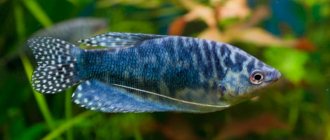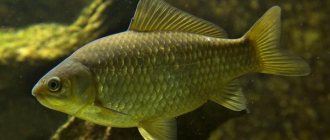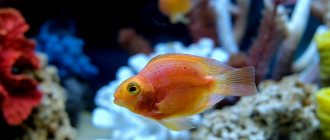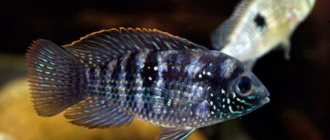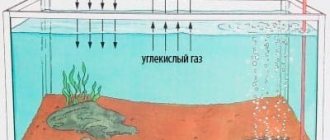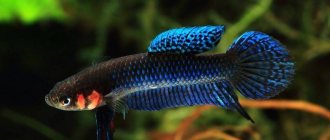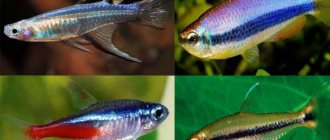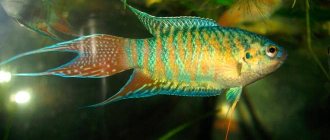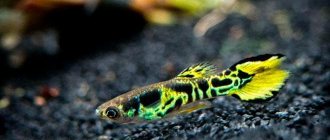Origin
The Lalius or dwarf filamentous gourami was first described in 1822 by Hamilton. This fish was found in South Asia in Pakistan, India, Bangladesh. Today it is found in Singapore, the USA and Colombia.
Currently, wild specimens are unlikely to be found in the aquarium hobby. These aquarium fish are widespread, selective varieties have been bred and have been bred in captivity for a long time.
In the wild, it is found in rice fields and inhabits slow-moving streams, streams, irrigation canals and other agricultural lands. They tend to live in areas with dense vegetation, such as the swamps of the Ganges, Baram and Borneo rivers. In nature, they are omnivores and feed on small invertebrates and algae.
An interesting feature of this species is the ability to watch for prey above the surface of the water. The fish stays level underwater and watches the prey above. By suddenly contracting the mouth cavity, it splashes drops of water on the victim, knocking it from a height into the water, where it will be immediately captured.
Appearance
Lalius are relatively small fish; in aquariums, males grow up to 7.5 cm, females are slightly smaller - up to 6 cm. The body is laterally compressed, narrow, and the fins are large. In the process of evolution, the pectoral fins have turned into thin threads that serve as an organ of touch.
Lalius are characterized by pronounced sexual dimorphism: males are much brighter in color, their dorsal and anal fins are more pointed. The body of males is silvery, with blue and red stripes along it, and the abdomen is colored purple. The fins have a red border. Females do not have such a magnificent outfit; their scales are grayish-green with inconspicuous stripes.
Lalius female
Currently, there are several color variations of lalius: red, blue, etc.
Blue variation of lalius
Reproduction
You can breed Lalius after the fish reach 5-6 months. By this time they become sexually mature. It won't be difficult to choose a pair. Due to pronounced sexual differences, distinguishing a female from a male is not difficult.
14:05
Breeding Lyalius
12:52
How I propagate lalius and corydoras for spawning...
03:00
BREEDING LALLIUS
For successful reproduction, preparation of a separate tank is required.
The requirements for the spawning tank are presented in the table:
| Tank volume | from 40 l |
| Water level | up to 15 cm |
| Temperature | 26-28оС |
| Rigidity | no more than 6dH |
| Acidity | 6-6.5 pH |
When arranging a spawning area, special attention should be paid to the presence of vegetation (richia, duckweed, lithium). Algae is necessary for the male to build nests.
For the correct formation of the labyrinth organ in fry, it is necessary to maintain heat and dampness in the tank. The problem is solved by using a glass lid or film covering the container.
Reproduction of Lalius is carried out as follows:
- Before spawning, the selected pair is seated in separate containers.
- Producers are fed live food in large portions.
- After the female’s abdomen has enlarged, she is released into the spawning area.
- After 3-4 days, a male is placed with the female, who immediately begins building a nest, which is a foam structure mixed with plant parts.
- After the construction of the nest is completed, mating games begin. The male, pressing on the female's abdomen, pushes the eggs out of her, simultaneously fertilizing. One female is capable of laying about 500-600 eggs.
- At the end of spawning, the male collects the eggs that did not make it into the nest, moving them to their place using his mouth.
- The female is removed from the spawning area. The “father” takes care of the eggs.
- 36 hours pass before the fry appear. 6-7 days after the larvae hatch, the boys leave the nest. After this, the male is removed.
During the first days, the young animals are fed as often as possible, given small food: ciliates, ground yolk, live dust. A little later, the diet is replenished with artemia, a microworm.
From time to time, young animals should be sorted, removing larger individuals. This will help avoid cannibalism among fellow creatures.
Flakes are added to the menu for fry that have grown to 1 cm. After 2 months, the young animals can be transferred to an adult aquarium.
Kinds
Let's look at which representatives of Lalius can be found. Kinds:
- Lalius neon is a fish that was bred through selection. It has a bright red color, which is why it is called red lalius. Has a blue comb on the dorsal fin. The red lyalius is a rather calm fish and has a small size. In the first days of the settlement, it can hide, because even small aggressive neighbors are frightened.
- Lalius cobalt - also bred by selection. This striped aquarium fish is 6 cm long, the body is slightly compressed on the sides, oval. Due to their small size, it is more convenient for them to chase insects. Males differ from females in having a pointed body and also have a shade of cobalt blue, while females are blue with a silver tone. In poor lighting, the scales give off different colors. The pelvic fins are more elongated, thereby resembling threads. The Cobalt Lalius is a schooling fish.
- Rainbow lyalius - in nature, this species has enhanced red tones in striped coloring. Females are dull, gray and brown tones predominate. For this reason, males are more often sold in pet stores.
- Lalius coral and blue lalius. In fact, the main difference is that the body color is predominantly red-brown or blue, respectively.
Reproduction of cobalt lalius
Breeding cobalt lalius is an absolutely simple task and is typical of all macropods. In fact, it can happen independently without the participation of an aquarist. The only thing is that you shouldn’t expect the same beautiful offspring from the cobalt selection morph. Young animals obtained from morphs will always strive for the natural form.
Lalius have clearly expressed sexual dimorphism. The male is large and brighter in color, while the female is small and has a simple silvery tint. As they mature, males, like all labyrinthine fish, develop elongated ends of the dorsal and anal fins.
Please note that it is important to keep the Lalius in a harem. They have highly developed intraspecific aggression. In a twenty-liter aquarium it is necessary to keep one male and two or three females. Adding another kid to the tank will cause fights and mayhem in the pond. Yes, male laliuses are more beautiful than females. But the concept of male friendship is not known to these fish. Several males can be kept in one aquarium, provided there is sufficient volume and the presence of females. In this case, the kibal boys will divide the territory and the ladies, and their aggressive clashes will be minimal.
As for the breeding itself, everything is simple. It is typical of all labyrinth fish. The males build a foam nest, squeeze out the female with the eggs, carry the eggs to the nest and incubate them there until the larvae emerge.
Perhaps the most important thing in this matter is to create ideal conditions for producers. The water is a little warmer, the aquarium is a little shaded, plants such as duckweed, pistia or riccia should float on the surface of the water. All this romantic atmosphere will contribute to the beginning of marriage games! More on this below.
A 15-20 liter container is suitable as a spawning aquarium. The water level is about ten centimeters.
The water should be soft. To soften water, it is better to use osmosis or distilled water. At worst, you should boil tap water and gradually soften the water in the neristovik. The hardness should be about 4 -6dH.
It is imperative to make thickets of plants in the corners of the aquarium so that the female has somewhere to hide from the aggressive male during the spawning period. Throw a bunch of grass onto the surface of the water, the same riccia that the male will use to build a nest from air bubbles.
It is advisable to keep the male and female separately a week before spawning and during this period feed them intensively, including herbal supplements. The temperature in the spawning tank is maintained using a thermostat at 23-25°C. Introduce the female first into the prepared aquarium and let her get comfortable there for a couple of days.
Cobalt lalius
Then the male is planted. He stands the nest and periodically chases the female, who hides from him in the thickets of plants. When the nest is ready, the female leaves the shelter and settles down with the male under the nest. The male wraps his body around the female's abdomen and squeezes the eggs out of her. The eggs are rich in lipids and therefore do not fall to the bottom, but rise to the surface. The male lalius picks them up with his mouth and places them in the nest.
After the end of spawning, the male begins to aggressively attack the female and can even kill her. Therefore, as soon as spawning is completed, the female must be removed. This must be done carefully, since the male lalius during this period attacks everything that approaches his nest. Thus, by attacking the net, he can jump out of the aquarium. Therefore, you first need to notice where the female is hiding and then, covering half of the aquarium with glass, quickly and carefully catch her.
The male takes care of the lalius nest himself. Adds air bubbles, removes spoiled eggs, protects the nest. Incubation lasts about 48 hours. And after another three to four days the fry will swim. Now you need to remove the male from the spawning tank and start feeding the fry with live dust or food for fry.
The fry grow relatively slowly and unevenly. Therefore, they need to be sorted periodically. As they grow, they are transferred to larger feeds. At approximately 1.5 - 2 months, males develop stripes characteristic of adults.
Contents
There is a very common belief that aquarium fish are one of the most unpretentious pets, and caring for them takes almost no time. In fact, the majority of fish, especially the most beautiful and large ones, require rather specific conditions of detention. And the aquarium itself must be cleaned and washed regularly.
Therefore, many novice amateur aquarists who do not take this fact into account later face a number of problems. In order to avoid this, beginners need to start with fish species that are truly less demanding in terms of keeping conditions and are patient with some mistakes of an inexperienced owner. For example, for starters, you can purchase aquarium fish such as lalius.
Lalius are decorative fish of the labyrinth family. Their sizes usually do not exceed 6 centimeters. Aquarium fish Lalius have a beautiful bright color, which is more pronounced in males. An aquarium with a volume of about 20 liters is quite enough for a pair of lalius. If you want to purchase a flock of Lalius, where there will be several males, then the volume of the aquarium should be at least 60 liters.
This is because males will share territory and can be quite aggressive towards each other, especially during the spawning season. If the male Lalius have enough space, then the division of the territory will take place quickly and quite peacefully. Also, the aquarium should have a lot of plants, including floating ones, since lalius live mainly in the upper layers of water. In addition, the male will use plants when building a nest. You can put a small layer of soil or sand at the bottom. Lalius are quite tolerant of temperature changes, but it is still better to maintain a constant temperature of at least twenty degrees, approximately 22-28°C. It is better to cover the aquarium loosely with glass so that the fish do not catch a cold.
In general, lalius are very delicate fish, but lalius do not have any special diseases. The only problem is peptic ulcer disease. An ulcer appears on the pet's body, usually on the back, and in most cases this leads to the death of the fish. Experts disagree on the definition of this disease, most often it is considered to be tuberculosis. If you start treatment at the earliest stage, the likelihood of recovery is much higher.
It also sometimes happens that the lalius lies at the bottom of the aquarium. This can either be a manifestation of stress or a sign of illness. In any case, it is better for you to consult with a specialist who will tell you what medications and what treatment your pet needs. At this time, the fish must be placed in a separate container.
Reviews
I've been dreaming about lalius for a long time, and then I accidentally saw these striped beauties in a pet store. I already had guppies, a female swordtail and rasboras in my aquarium. I bought one male lalius. The fish lived peacefully and did not offend anyone. Unfortunately, he died when they forgot to close the lid of the aquarium. They didn't think he would jump out of the water. Angelina Mezentseva, 32, Kurgan
I keep lalius with angelfish, mollies and guppies. I must say that these are the calmest pets. They love privacy, fortunately I have a lot of plants in my aquarium. I feed dry and live food, but I noticed that the color becomes brighter after live food. Nikolai Petrovich
I love lalius. Colorful, with shining stripes, they look simply luxurious. They are easy to care for, you can save on a compressor and not listen to the whirring of the aerator all day long. MMarina_L
How and what to feed lalius
The owner should take care of a balanced and nutritious diet for his bright charges. The menu can be composed of live, frozen, plant foods. It is important to consider that lalius swallow most of their food from the water surface, so the best food for them is flake diets. They do not immediately dissolve and drown, floating on top for some time. But the product should not float for long, since uneaten particles begin to rot and decompose, polluting the aquatic environment.
Fast-sinking food is not suitable for these fish; lalius rarely sink to the bottom. If some of the food does settle, it is worth considering the envy of the cleaner fish - corydoras, which will clean the soil from food remnants. Lalius are gluttons and are able to absorb much more food than they need. Therefore, the owner should dose the food - this will prevent the fish from overeating.
Features of aquarium maintenance
These small pets can live in a 10-liter container. But experienced aquarists still recommend purchasing a 50-60 liter aquarium for 3-4 individuals. In addition, the needs of the Lalius should be taken into account so that they live comfortably:
- the temperature of the water in the tank should be room temperature; sudden changes will not benefit these inhabitants;
- Lalius belong to the labyrinth fish, so they need to frequently capture oxygen from the surface - if the air and water temperatures are different, the labyrinth apparatus of the individuals may be damaged;
- It is advisable to cover the aquarium with a lid - this will protect the fish and help them avoid hypothermia;
- it is worth protecting them from strong currents;
- filtering water is desirable, but not necessary;
- the container should contain dense vegetation, including floating vegetation, shelters, grottoes and caves;
- The aquarium should be placed away from noise and bright light sources;
- a male should have several females - this will reduce the likelihood of conflict situations;
- Water that meets the following parameters is considered suitable: temperature – 24°-28°С, pH – 6.0-8.0, hardness – 5-18 dGH.
Compatibility with other fish
Any fish that has an equally quiet disposition and similar habitat requirements can become neighbors of the Lalius, if you need to purchase them. But you should still choose individuals that prefer to live in the lower and middle horizons of the aquarium. First of all, with their presence they will give life to these empty layers.
They will not interfere too actively with the measured life of the Lalius, who prefer to spend almost all their time near the surface of the water. They will not destroy nests built by male lalius, and if spawning of lalius suddenly happens in a common aquarium, this guarantees the survival of the offspring.
The lalius fish, whose compatibility with other ornamental fish is relatively good, still does not get along well with overly active representatives of the fish kingdom.
You should avoid purchasing fish that reach the feeder much earlier than their slow labyrinthine relatives, managing to eat the most delicious morsels. Sometimes they can leave their slow competitors without food at all.
Aquarium fish Lalius have a good appetite, but are not prone to excessive gluttony. In their natural habitat, the basis of their diet is flying insects that accidentally fell onto the surface of the reservoir. Feeding these fish is not particularly difficult. Lalius perfectly eat any food that is suitable for them in size.
The main condition is that the food remains on the surface of the water for as long as possible without sinking to the bottom. The fish comes down after him with great reluctance. Corerta, daphnia or cyclops are perfectly eaten by lalius. Small bloodworms will also be a huge success.
You can also diversify the food for this fish by adding flakes that are balanced in composition. It will not be superfluous to periodically add products of plant origin, in particular wolffia, to the feed.
Care and maintenance
Lyalius are gregarious creatures. Feels better in the company of relatives. Therefore, it is better to purchase 3-4 individuals at once.
It is recommended to place the aquarium away from noise to protect timid fish from loud sounds.
In nature, labyrinths are able to survive even in unfavorable conditions, but an artificial pond must meet certain requirements. This is especially true for breeding forms with weak immunity.
The table shows the water parameters that ensure the comfortable life of 1 individual:
| Volume of water (liters per 1 individual) | Temperature (°C) | Acidity (pH) | Hardness (dGH) |
| 30 | 23-28 | 6-7,5 | 5-18 |
Laliuses require weekly water changes, but can do without an aeration system.
The bright colors of the fish look impressive against the background of dark soil. The composition of the substrate is selected in accordance with the selected plants, which should form dense thickets. This can be either planted in the substrate or floating algae. Plants, along with caves and grottoes, serve as excellent shelter for lalius.
Lyalius feels comfortable in an aquarium with a large number of plants.
These labyrinths are not picky in their diet; they can eat any food: frozen, live, dry. The main thing is that the diet is balanced, and that the food is small and able to float on the surface of the water. This makes it easier for lalius to swallow food.
The diet of labyrinths may include:
- dry flakes;
- tubifex;
- Artemia;
- coretra.
They feed the fish several times a day, but at the same time strictly monitor the amount of food. Gluttonous laliuses are able to eat more than necessary, which leads to obesity in pets. Which in turn can cause many diseases and early death.
03:22
Satisfied and well-fed fry of lalius
03:42
LALIUS. MAINTENANCE, CARE, COMPATIBILITY AND FEEDING
09:26
Unrealistically cool nest! Lyalius breeding!
Spawning
You can follow this process without moving the lalius into another vessel. But this approach does not guarantee that the offspring will survive entirely; on the contrary, you can say goodbye to half the eggs. The male copes well with his functions and protects the nest, but cannot save all the offspring. The fry are not completely protected either. If you want to preserve the offspring of fish, it is better to place them in a separate aquarium.
By the behavior of the male, you can find out whether the pair is ready for spawning. Before this important event, the male begins to more actively create a place for future offspring. If you see parts of floating plants in the aquarium, you can move the fish to another place. The main thing to consider when preparing the spawning tank is that the water in it should be warmer than 28-30°C. You also need to turn off water filtration.
Spawning in Lalius begins after the completion of nest formation. While the female spawns, the caring father of the family places the eggs in foam and covers it with a layer of bubbles. It is important to remove the female from the aquarium after the entire process is completed. Her intervention will only distract the male from caring for the nest. The owner of the aquarium is only required to maintain the required temperature in the vessel. But you should not interfere with the male’s work in caring for the nest, otherwise he will destroy the eggs.
It is worth noting that Lalius are very prolific, so even if some of the offspring were not preserved, there will be many new residents in the aquarium. By the way, the fry have an excellent appetite; you need to always have food in the aquarium.
Compatibility
Lalius are calm, peace-loving fish and will be good neighbors. But aggressive inhabitants of the underwater world are able to frighten them and pluck their ventral filamentous fins.
They live calmly with the following fish:
- gourami;
- barbs,
- some types of catfish, tetras;
- rasboras;
- dwarf cichlids;
- small characins, carp.
Poor compatibility with goldfish, guppies, male bettas. But if there is a lot of algae, aggressive species will not be able to chase the Lyalius, which will hide in the greenery.
When introducing several males into an aquarium, problems may arise. They get into fights during the breeding season.
If there is a need to have males, then a larger container is needed. The pair can be kept separately, since the male can be aggressive towards the female when he begins to court her.
Diseases
When buying fish, pay attention to the individuals and ask about their origin. At one time, there was a boom in the import of unhealthy individuals from Singapore, so quite a lot of carriers of dwarf iridovirus were imported - this disease is incurable. Therefore, do not buy apathetic aquarium fish.
Based on some signs in fish, popular diseases of lalius can be identified. For example, darkening of the color and redness of the pectoral fins is a sign of furunculosis. But if crumbling scales and an enlargement of the abdomen appear - pseudomonosis.
If the lalius is overtaken by diseases, they are treated by raising the temperature of the water, as well as with special solutions that can be purchased at a pet store. Remember that the main protection against disease is simply caring for your aquarium (cleaning the aquarium, aeration, water purity and temperature).
